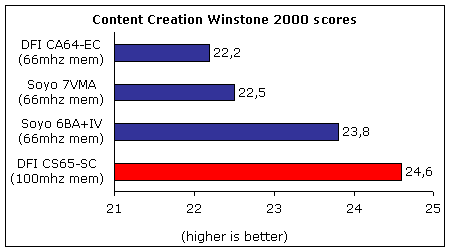|

|
The Intel i815 chipset can be considered as the true successor of the renowned Intel 440BX chipset. Starting from the 810, Intel has shifted its position from the standard north/south bridge design in favour of what they like to call Accelerated Hub Architecture, or AHA for short. Under this particular design, there are 3 individual hubs: the Graphics and Memory Controller Hub (GMCH), the I/O Controller Hub (ICH) and the Firmware Hub (FWH). The GMCH and the ICH are connected through an internal bus, which offers a bandwidth of 266MB/sec (twice as fast as the PCI).
90% Rating: 
|
|
|
|
Home >
Reviews >
Motherboards >
DFI CS65 SC |
|
|
Installation and Testing
The installation of the CS65 SC went along smoothly without
hitches. The board can automatically detect the CPU type & FSB. Windows 98
installation went fine and all the necessary drivers were easy to
install.
Testbed Setup
| |
OEM Intel
Celeron 566MHz FC PGA |
| |
Tested
boards: DFI CS65 SC (Intel 815), Soyo 6BA+IV (Intel BX), Soyo 7VMA (VIA
PM133), DFI CA64 EC (VIA Apollo Pro 133A with ATA 100
support) |
| |
128 MB
PC 100 CAS 2 SDRAM |
| |
3dfx Voodoo5
5500 AGP |
| |
Western
Digital 30GB ATA 66 hard drive, 5400 RPM |
| |
Orchid
Nusound 3D (Aureal Vortex 1 sound card) |
| |
NEC 5500A
DVD ROM (8x/40x) |
The memory speed on the Soyo 6BA+IV was 66MHz as the Intel BX does not
provide support for asynchronous memory/CPU FSB. The Soyo 7VMA was unstable when
we used the HCLK+33MHZ (100MHz) BIOS memory option, so we had to stick with
66MHz. Our DFI CA64 EC board didn't have any option for asynchronous memory/CPU
operation, so its memory access was also left at 66mhz. The only board that had
a working 100MHz memory operation was the CS65 SC.
All BIOS settings were
tweaked for maximum performance on all of the tested boards. On all of the tests
we used the Orchid Nusound PCI soundcard for audio output instead of the
integrated AC97 codec, unless noted otherwise.
Business
Performance
 |
The CS65 SC excels in the Content Creation Winstone 2000 performance
suite. This was somewhat expected since the rest of boards were using a slower
66MHz memory bus (for reasons we previously explained). If the DFI CA64 EC and
the Soyo 7VMA were running memory at 100MHz, they could have reached performance
levels of the CS65 SC. Only the 6BA+IV, based on the powerful Intel BX, is
capable of keeping up with the CS65 SC even though it uses 66MHz memory
access.
The Business Winstone 99 performance of the CS65 SC was top notch. But
this time, the performance differences are relatively smaller than those seen on
Content Creation Winstone 2000.
|
|
|
|
